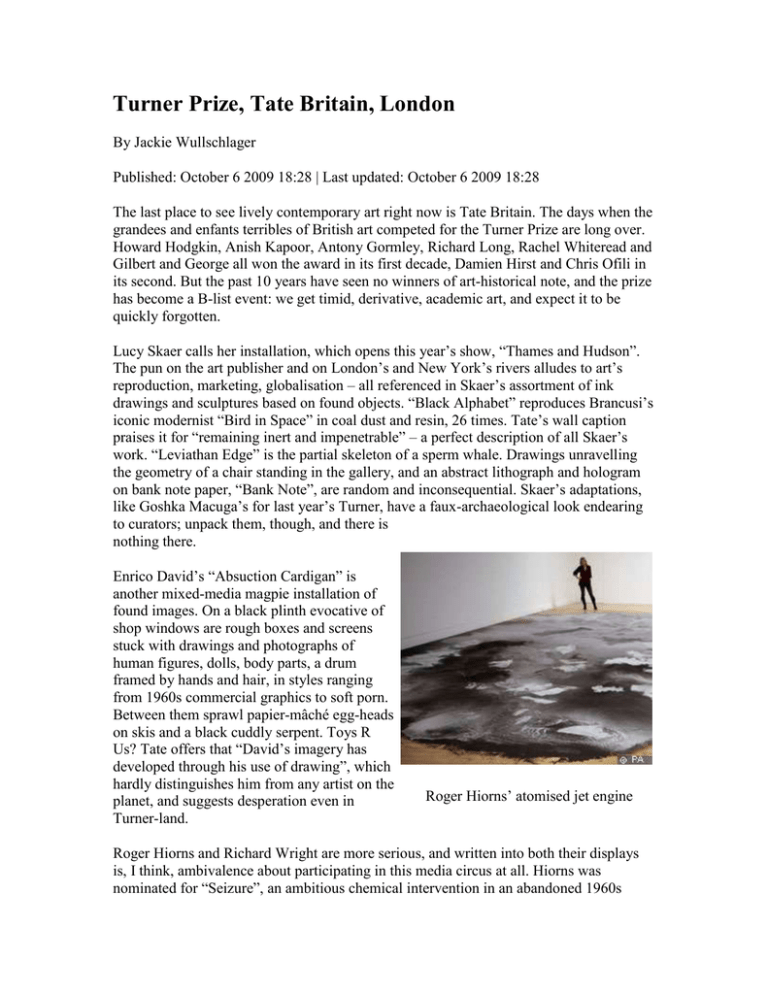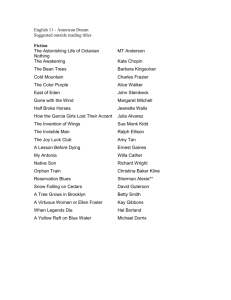Turner Prize FT Oct 09
advertisement

Turner Prize, Tate Britain, London By Jackie Wullschlager Published: October 6 2009 18:28 | Last updated: October 6 2009 18:28 The last place to see lively contemporary art right now is Tate Britain. The days when the grandees and enfants terribles of British art competed for the Turner Prize are long over. Howard Hodgkin, Anish Kapoor, Antony Gormley, Richard Long, Rachel Whiteread and Gilbert and George all won the award in its first decade, Damien Hirst and Chris Ofili in its second. But the past 10 years have seen no winners of art-historical note, and the prize has become a B-list event: we get timid, derivative, academic art, and expect it to be quickly forgotten. Lucy Skaer calls her installation, which opens this year’s show, “Thames and Hudson”. The pun on the art publisher and on London’s and New York’s rivers alludes to art’s reproduction, marketing, globalisation – all referenced in Skaer’s assortment of ink drawings and sculptures based on found objects. “Black Alphabet” reproduces Brancusi’s iconic modernist “Bird in Space” in coal dust and resin, 26 times. Tate’s wall caption praises it for “remaining inert and impenetrable” – a perfect description of all Skaer’s work. “Leviathan Edge” is the partial skeleton of a sperm whale. Drawings unravelling the geometry of a chair standing in the gallery, and an abstract lithograph and hologram on bank note paper, “Bank Note”, are random and inconsequential. Skaer’s adaptations, like Goshka Macuga’s for last year’s Turner, have a faux-archaeological look endearing to curators; unpack them, though, and there is nothing there. Enrico David’s “Absuction Cardigan” is another mixed-media magpie installation of found images. On a black plinth evocative of shop windows are rough boxes and screens stuck with drawings and photographs of human figures, dolls, body parts, a drum framed by hands and hair, in styles ranging from 1960s commercial graphics to soft porn. Between them sprawl papier-mâché egg-heads on skis and a black cuddly serpent. Toys R Us? Tate offers that “David’s imagery has developed through his use of drawing”, which hardly distinguishes him from any artist on the planet, and suggests desperation even in Turner-land. Roger Hiorns’ atomised jet engine Roger Hiorns and Richard Wright are more serious, and written into both their displays is, I think, ambivalence about participating in this media circus at all. Hiorns was nominated for “Seizure”, an ambitious chemical intervention in an abandoned 1960s London housing block. He filled a disused bedsit with 75,000 litres of copper sulphate that encrusted every surface with luminous blue crystals: a fantastical modernist dystopia. His work here too turns on material transformations. Two wall sculptures composed of bovine brain matter and plastic are shaped in organic forms suggestive of a foetus, a seahorse. A third is a geometric construction of stainless steel and brain matter. Undulating heaps of grey-black metal dust are remnants of an atomised passenger jet engine. Hiorns graduated in 1996 from Goldsmiths, the Young British Artists’ alma mater. In his search for a new materiality, and his dust-to-dust pessimism, he is a classic Hirst descendent. The territory he has chosen, though, is difficult to occupy without resorting to gimmickry. “Seizure” was spectacular, but it is unclear from this slight display that Hiorns’ art of transitions and transitoriness has anywhere to go. Richard Wright’s gamble with the ephemeral is the riskiest in the show, and produces its most beautiful work. Wright improvises short-lived wall-paintings in specific architectural contexts; we know they will be washed away at the show’s end, and their transience adds poignancy to their lustre. The intricate gold-leaf painting covering a single wall here is his most complex yet: blending rhythmic patterns, baroque ornamentation, typography, he combines abstraction with figurative elements – tiger, cherub, cartoonish face, waves – in an elegant, liquid flow. The all-over junkscape, referencing our speeded-up visual overload, exists in tension with unlikely historical resonances – William Blake, Richard Long – and painstaking detail, which slows down looking. Wright is a conceptualist, musing on the meanings, uses, markets, values for painting today. From the slim pickings here, I would be torn between giving the prize to him or to Hiorns for “Seizure”. Both would be deliberately transient works with which to win the Turner; it is a sad reflection of the prize’s now fleeting significance that they would thus be appropriate ones.



